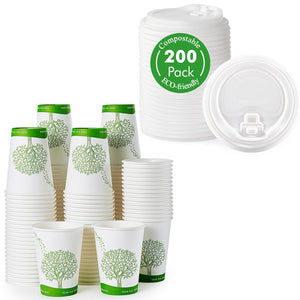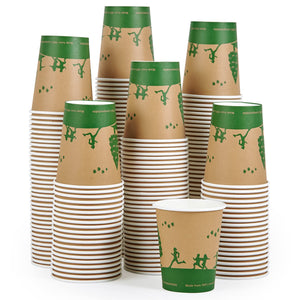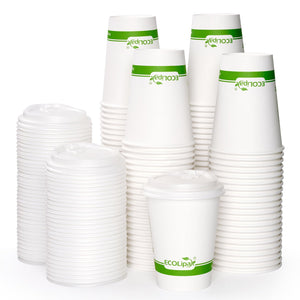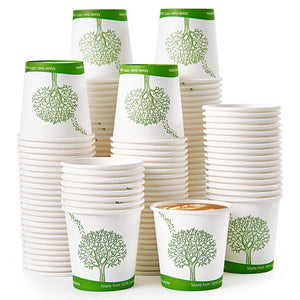The demand for environmentally friendly products is rising quickly. Ecolipak leads this change with its sustainable 12 oz paper cups. These compostable paper cups use plant-based materials, offering a real path to sustainability. This directly addresses a major problem for the environment.
Shockingly, over 99% of traditional paper cups are not recycled and end up in landfills.
Ecolipak's eco-friendly, compostable design provides a truly sustainable alternative for consumers.
Key Takeaways
Most paper cups are not recycled. They have a plastic lining that makes them hard to break down.
Traditional paper cups end up in landfills. They release harmful gases and microplastics into our environment.
Ecolipak cups use plant-based materials. They are compostable and turn into soil in special facilities.
Ecolipak cups are safe for you. They do not contain harmful chemicals like BPA.
Choosing Ecolipak cups helps the planet. They offer a convenient and responsible choice for single-use cups.
THE PROBLEM WITH TRADITIONAL CUPS
Many people believe the paper cups they use every day are a responsible choice. However, the reality is much more complex. The design of most single-use cups creates significant challenges for our planet, from manufacturing to disposal. Understanding these issues reveals why a change is so urgently needed.
THE CHALLENGE OF PAPER CUP RECYCLING
At first glance, paper cups seem simple to recycle. The problem lies in a hidden layer. Most paper cups contain a thin lining of polyethylene (PE), a plastic made from fossil fuels like petroleum. This lining makes the cups waterproof but creates a major hurdle for paper cup recycling.
Standard recycling facilities are not equipped to handle these mixed materials. The plastic lining must be separated from the paper fiber, a process that is difficult and expensive.
Most recycling centers cannot separate the tightly bonded plastic film from the paper. This causes the plastic to clog machinery, disrupting the entire recycling operation.
As a result, these items are often rejected. This means that even when you place them in a recycling bin, they are not truly recyclable. This makes the idea of recyclable paper cups a myth in most communities.
FROM YOUR CUP TO THE LANDFILL
Since the vast majority of paper cups are not recyclable, they end up in landfills. Here, their environmental impact continues to grow. A PE-lined paper cup can take more than 20 years to break down. During this slow decomposition process, they release methane. This gas is a powerful greenhouse gas that contributes to climate change. The environmental impact of disposable paper cups in landfills is a serious concern. The journey from a coffee shop to a landfill highlights a broken system that needs a better solution than conventional recycling.
THE HIDDEN IMPACT OF MICROPLASTICS
Beyond the landfill, there is another invisible threat: microplastics. Scientific studies show that when hot liquids are poured into PE-lined paper cups, the plastic lining can shed millions of tiny plastic particles directly into the beverage. High temperatures accelerate this process, meaning your hot coffee or tea could contain these unseen particles.
These microplastics create widespread environmental impacts. They wash into our waterways, where they are consumed by wildlife and enter the food chain. This hidden danger shows that the problems with non-recyclable paper cups go far beyond just waste and recycling.
ECOLIPAK: THE FUTURE OF SUSTAINABLE PAPER CUPS
The problems with traditional cups demand a better solution. Ecolipak provides that solution with its innovative 12 oz paper cups. These eco-friendly paper cups are not just a temporary fix. They represent a fundamental shift toward true sustainability. By using smart design and plant-based materials, Ecolipak offers a path away from landfill waste and toward a healthier planet. These sustainable paper cups are the future.
PLANT-BASED MATERIALS: PLA AND CPLA
Ecolipak paper cups get their strength from nature. Instead of a plastic lining made from fossil fuels, they use a lining made of Polylactic Acid (PLA). PLA is a bioplastic derived from renewable resources like corn starch. The process starts with plants, which are converted into a durable, food-safe material. This makes the entire cup compostable.
The lids are just as important. Ecolipak uses Crystallized Polylactic Acid (CPLA) for its lids, creating a complete eco-friendly package. CPLA is a special form of PLA designed to handle heat. This makes it perfect for hot coffee or tea.
PLA vs. CPLA: What's the Difference?
Property
PLA (Cup Lining)
CPLA (Lid)
Heat Resistance
Lower (Best for cup body)
Higher (Up to 176°F)
Best For
Holding hot and cold drinks
Securely covering hot drinks
Material
Plant-based bioplastic
Crystallized plant-based bioplastic
End-of-Life
Compostable
Compostable
This combination of sustainable materials ensures the entire product, from cup to lid, can return to the earth.
DESIGNED FOR COMMERCIAL COMPOSTING
A key feature of these compostable paper cups is their end-of-life design. Ecolipak paper cups are made to be commercially compostable. This means they will not break down in a backyard compost pile. They require the specific conditions of an industrial composting facility.
In these facilities, high temperatures (around 140°F) and microorganisms work together. They break down the PLA-lined cups and CPLA lids into natural elements. This process can take as little as 60-90 days. The cups and lids become soil, carbon dioxide, and water. This avoids the landfill completely. It turns waste into a useful resource, a core principle of sustainability. These compostable products offer a real circular solution.
A TRULY SUSTAINABLE CHOICE
Choosing Ecolipak is a sustainable choice that does not sacrifice quality. Many customers find that these sustainable paper cups perform just as well as, or even better than, traditional options. The thoughtful design delivers a great user experience.
Users often praise the cups for their sturdiness and reliability:
They are leak-free, keeping liquids securely inside.
They work perfectly for both hot and cold beverages.
The cups hold their structure for hours without getting soft.
These features prove that sustainability can go hand-in-hand with performance. By choosing these eco cup options, consumers support a system that relies on renewable resources and reduces landfill waste. Ecolipak provides one of the best sustainable packaging solutions available today.
BPA-FREE AND FOOD-GRADE SAFE
Health is just as important as environmental impact. Many plastic products contain a chemical called Bisphenol A (BPA). Health experts classify BPA as an endocrine disruptor. This means it can interfere with the body's hormones and has been linked to various health concerns, especially for children. The chemical can move from containers into food and drinks.
Ecolipak's 12 oz paper cups and lids are completely BPA-free. They are made from food-grade, plant-based materials. This gives families and individuals peace of mind. You can enjoy your favorite beverage without worrying about harmful chemicals. These compostable paper cups are a safe choice for you and a sustainable one for the planet. They are fully biodegradable and compostable.
THE PATH TO TRUE SUSTAINABILITY
Choosing the right cup can feel complicated. Many options exist, but not all lead to true sustainability. Understanding the differences helps people make a better choice for the planet. Ecolipak offers a clear path forward, turning everyday convenience into a responsible action.
COMPOSTABLE VS. CONVENTIONAL
The main difference between compostable paper cups and conventional ones is their end-of-life journey. Conventional paper cups have a polyethylene (PE) plastic lining. This lining makes recycling nearly impossible for most facilities. As a result, these non-recyclable paper cups end up in landfills.
Ecolipak’s compostable cups use a plant-based PLA lining. This design allows them to be commercially compostable, avoiding the problems of traditional recycling. The difference is significant.
Feature |
Composted Ecolipak Cup |
Landfilled Conventional Cup |
|---|---|---|
End-of-Life |
Becomes nutrient-rich soil |
Sits in a landfill for decades |
Breakdown Time |
90–180 days (industrial) |
20+ years |
Microplastics |
Avoids microplastic pollution |
Sheds microplastics into the environment |
Recycling |
Not designed for recycling |
Not truly recyclable in most systems |
This shows why the idea of recyclable paper cups is often misleading. A compostable cup offers a real solution.
ECOLIPAK'S 12 OZ PAPER CUPS
Ecolipak’s 12 oz paper cups embody the brand's commitment to sustainability. The company's mission goes beyond a single product. It focuses on creating a healthier planet through better packaging. This dedication has already made a huge impact.
In 2024 alone, Ecolipak sold over 59 million eco-friendly products. This helped protect thousands of square feet of green space.
Choosing these sustainable paper cups means joining a large and growing community. Each cup supports a system built on renewable resources and responsible disposal. It is a simple step that contributes to a much larger goal of global sustainability.
CONVENIENCE MEETS RESPONSIBILITY
Many people consider reusable cups the most sustainable option. Reusable cups are excellent, but they have their own environmental footprint. Manufacturing them requires significant energy and resources. They must be used many times—sometimes over 100 times—to offset their initial impact. Washing them also uses water and energy.
For events, travel, or busy mornings, a reusable cup is not always practical. This is where Ecolipak provides a perfect balance. These compostable 12 oz paper cups offer the convenience of a single-use product without the long-term waste. They support sustainable forestry practices and are designed for a circular system. This makes them a responsible and eco-friendly choice when reusables are not an option. They make sustainable practices easy to adopt.
Ecolipak's compostable cups provide a clear solution to landfill waste. Their innovative, plant-based design makes them a truly compostable product. Choosing these sustainable cups is a simple yet powerful step toward a circular economy. This choice supports long-term sustainability and reduces environmental impact. Make the switch to a sustainable, compostable future.
Green Pack, Go for ECOLipak.
FAQ
How are Ecolipak cups different from regular paper cups?
Ecolipak cups use a plant-based PLA lining, making them fully compostable. Most traditional cups use a petroleum-based plastic lining. This plastic makes them very difficult to recycle, so they usually end up in landfills. Ecolipak offers a truly sustainable end-of-life solution.
Are Ecolipak cups safe for my family?
Yes, they are very safe. Ecolipak cups and lids are 100% BPA-free and made from food-grade materials. This ensures your beverages remain pure and free from harmful chemicals. They are a healthy choice for everyone in your family.
Can I compost these cups in my backyard?
Ecolipak cups require a commercial composting facility. These facilities provide the high heat and specific conditions needed for the cups and lids to break down properly. They will not decompose correctly in a typical home compost pile.
Can these cups be used for both hot and cold drinks?
Absolutely. These cups are designed for versatility. They hold their structure perfectly with both hot and cold beverages. The included CPLA lids are specially made to handle hot drinks, providing a secure, leak-resistant fit for your convenience.









